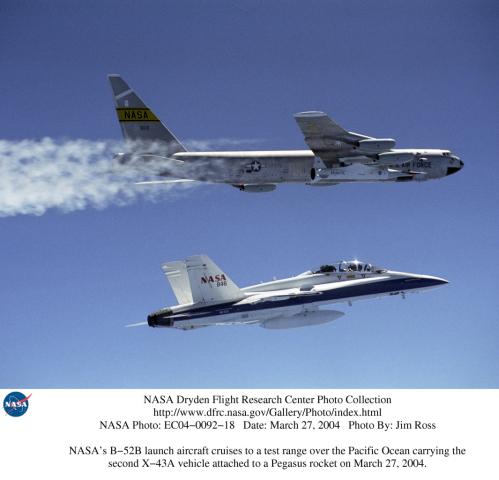Launched a UAV with a new jet engine, which reached a speed of 8,000 km/h. Agency officials: This may be the beginning of the revolution in aviation. The experiment will advance the development of an airplane that will take passengers anywhere in the world in two hours
News and voila!

NASA's innovative UAV. 1,400 kg, 4 meters and a lot of speed (photo: NASA website)
Direct link to this page: https://www.hayadan.org.il/x4329004.html
Tonight, NASA managed to launch an unmanned plane into space with a modern type of jet engine, the plane reached an altitude of 33,000 m at a record speed of 8,000 km/h, performed a series of exercises and crashed, as planned, into the sea.
The experiment carried out by the American space agency was successful and lasted 10 seconds, as planned by NASA. According to senior officials at the agency, "this may be the beginning of the revolution in aviation". Scientists estimate that the success of the experimental launch of X-43A - an unmanned aircraft with a modern type of jet engine - may lead to a cheaper launch of cargo into space, and may even promote the development of an aircraft that can transport people to any point in the world within two hours. The state-of-the-art plane hovered in the air for six minutes before it crashed into the sea.
As part of the experiment, in which the function of a supersonic combustion engine ("Scramjet") was tested, the X-43A reached a speed of approximately 8,000 km/h - seven times the speed of sound. The X-43A is the first plane that "sucks air" and is not propelled by a rocket, reaching supersonic speed.
A NASA B-52 released the unmanned aircraft (which weighs about 1,400 kg and is about four meters long), attached to the missile, at a height of about 13 meters above the Pacific Ocean. The missile accelerated the plane, which is made of steel and aluminum alloy, to a speed of Mach 7 and brought it to a height of about 33 thousand meters - then it broke away from it. After disconnection, the engine burned for 10 seconds and accelerated the X-43A to a speed of about 8,000 km/h. At this speed, the plane performed a series of maneuvers, before crashing into the sea.
AdvertisementAccording to experts, planes with supersonic combustion engines (scramjet), like that of the X-43A, may reach a speed of thousands of km/h. According to them, rockets propelled with their help will be able to carry more cargo to orbit outside the atmosphere. The explanation for this is that these engines will eliminate the need to carry liquid oxygen, which is used for combustion today and weighs a lot.
The supersonic combustion engine has been tested for the past few decades in laboratories, but has never been successfully flown. This is not the first time an attempt has been made to fly the X-43A. In June 2001, such an experiment was conducted, but it failed after the missile that carried the plane (of the "Pegasus" type) deviated from its trajectory after being released from the B-52.
https://www.hayadan.org.il/BuildaGate4/general2/data_card.php?Cat=~~~805058631~~~142&SiteName=hayadan
